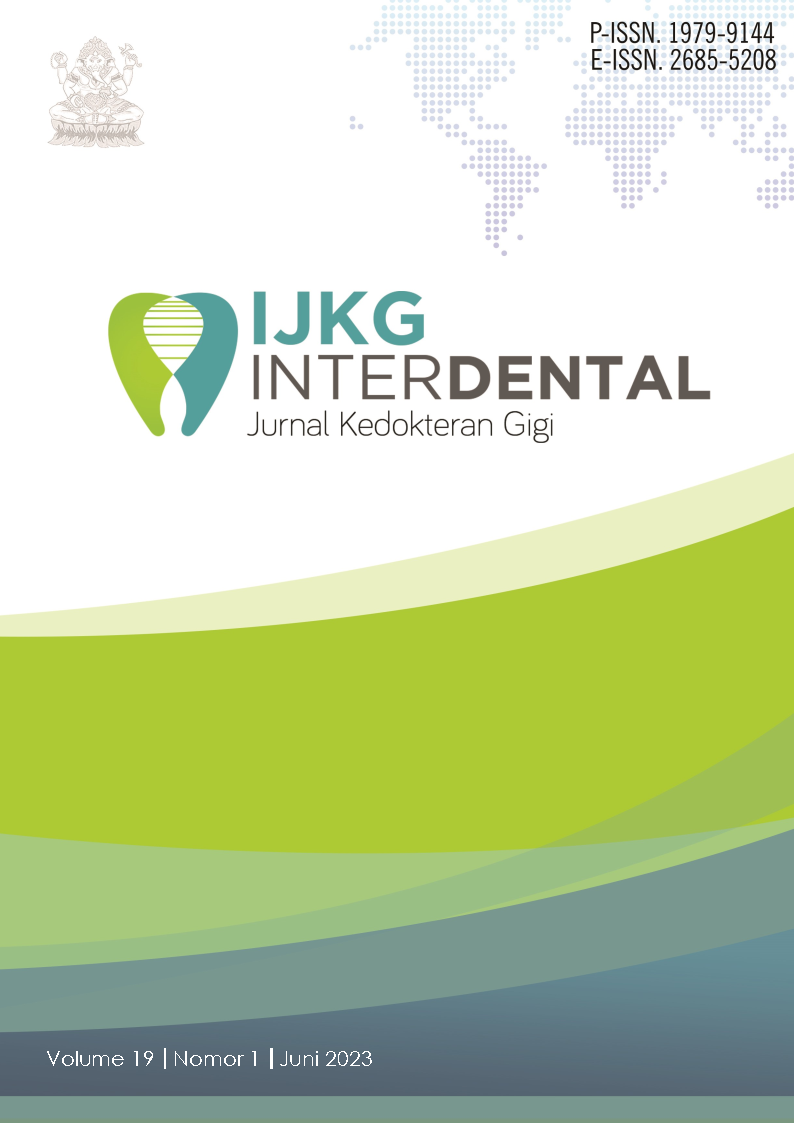THE USE OF CHLORHEXIDINE MOUTHWORKS CAN REDUCE THE ACCUMULATION OF DENTAL PLAK IN USERS OF FIXED ORTHODONTIC DEVICES
PEMAKAIAN OBAT KUMUR KLORHEKSIDIN DAPAT MENURUNKAN AKUMULASI PLAK GIGI PADA PENGGUNA PIRANTI ORTODONTI CEKAT
DOI:
https://doi.org/10.46862/interdental.v19i1.6095Keywords:
Orthodontic appliances, dental plaque, oral hygiene, chlorhexidineAbstract
Introduction: Treatment of malocclusion with fixed devices is common for us to encounter everyday. In using this device there are parts that are glued to the teeth and cannot be disassembled by the patient himself. This allows food debris and plaque to adhere more easily to the teeth and the fixed appliance. Review: Dental plaque is a transparent thin layer that adheres tightly to the teeth, which contains bacteria and their products in the form of organic and inorganic materials, oral fluids, loose epithelial cells and blood cells. Plaque is influenced, among other things, by bacteria, buffers and salivary flow, the presence of fluoride and the frequency of carbohydrates consumed, crowding of teeth, rough surfaces, areas that are difficult to clean, position of teeth outside the area of occlusion, and multiplication of bacteria. Therefore, during the process of fixed orthodontic treatment, it is necessary to control plaque which is carried out mechanically or chemically. Mechanical plaque control can be done by brushing teeth and using dental floss, while chemical plaque control can be done by using mouthwash. The mouthwash that has proven to be the most effective of the other therapeutic plaque control agents is chlorhexidine because it is able to ionically adhere to teeth and oral mucosal surfaces in high concentrations for hours. Chlorhexidine 0.2% can affect the number of salivary bacterial colonies due to the phenol content contained therein. Chlorhexidine itself has a very strong binding ability in the oral cavity, which is its advantage compared to other ingredients. Conclusion: Gargling with chlorhexidine can reduce plaque accumulation and improve oral hygiene status in fixed orthodontic users
Downloads
References
Rahardjo P. Ortodonti Dasar Edisi Kedua. Surabaya: Airlangga University Press; 2012. p. 128-137.
Diah NMYS, Anggraeni PI, Hutomo LC. Status kesehatan gingiva pengguna peranti ortodontik cekat pada mahasiswa Fakultas Kedokteran Universitas Udayana, Denpasar, Bali. Intisari Sains Medis. 2019; 10(1): 126.
Mantiri SC, Wowor VN, Anindita PS. Status kebersihan mulut dan status karies gigi mahasiswa pengguna peranti ortodontik cekat. Jurnal e-Gigi. 2013; 1(1): 2.
Rezki S, Pawarti. Pengaruh pH plak terhadap angka kebersihan gigi dan angka karies gigi anak di klinik pelayanan asuhan poltekkes pontianak tahun 2013. ODONTO Dental Journal. 2014; 1(2): 13.
Ristianti N, Kusnanta J, Marsono M. Perbedaan efektifitas obat kumur herbal dan non herbal terhadap akumulasi plak di dalam rongga mulut. Jurnal Medali. 2015; 2(1): 32.
Pariati, Angki J. Perbedaan kumur chlorhexidine terhadap skor gingivitis pasien ortho cekat usia 15-30 tahun di praktek drg. Sofyan Makassar. Media Kesehatan Gigi. 2019; 18(1): 60.
Rubiarta PCN. Peningkatan pelepasan ion Fe (ferrum) pada kawat stainless steel ortodonti yang direndam dalam minuman berkarbonasi. Skripsi. Jember: Fakultas Kedokteran Gigi; 2018.
Mauna S, Purbiati M, Krisnawati K. Angulasi gigi pasca perawatan ortodonti dengan pencabutan dan tanpa pencabutan. J Dent Indo. 2009; 16(1): 46-52.
Alawiyah T. Komplikasi dan resiko yang berhubungan dengan perawatan ortodonti. Ilmiah Widya. 2017; 4(1): 256-261.
Foster TD. Buku Ajar Ortodonsi. 3rd ed. Jakarta: EGC; 2012.
Lastianny SP. Dampak pemakaian peranti ortodontik terhadap kesehatan jaringan periodontal. Majalah Kedokteran Gigi Indonesia. 2012; 19(2): 181.
Rose LF, Mealey BL, Genco RJ, Cohen DW. Periodontics medicine, surgery, and implants. Missouri: Elsevier Mosby; 2004.
Wiradona I, Widjanarko B, Syamsulhuda BM. Pengaruh perilaku menggosok gigi terhadap plak gigi pada siswa kelas IV dan V di SDN Wilayah Kecamatan Gajahmungkur Semarang. Jurnal Promosi Kesehatan Indonesia. 2013; 8(1): 60.
Kasuma, Nila. Plak Gigi. Ed 1. Padang: Andalas University Press; 2016. p. 2-10.
Manson JD, Eley BM. Buku ajar periodonti. 2nd ed. Jakarta: Hipokrates; 2013.
Megananda. Ilmu pencegahan penyakit jaringan keras dan jaringan pendukung gigi. Yogyakarta: EGC; 2008.
Syahida Q, Wardani R, Zubaedah C. Tingkat kebersihan gigi dan mulut siswa usia 11-12 tahun di SDN Cijayana 1 Kabupaten Garut. Jurnal Kedokteran Gigi Unpad. 2017; 29(1): 59.
Talumewo M, Mintjelungan C, Wowor M. Perbedaan efektivitas obat kumur antiseptik beralkohol dan non alkohol dalam menurunkan akumulasi plak. Pharmacon. 2015; 4(4): 2.
Nareswari A. Perbedaan efektivitas obat kumur chlorhexidine tanpa alkohol dibandingkan dengan chlorhexidine beralkohol dalam menurunkan kuantitas koloni bakteri rongga mulut. Skripsi. Surakarta: Fakultas Kedokteran Universitas Sebelas Maret Surakarta; 2010.
Sinaredi BR, Pradopo S, Wibowo TB. Daya antibakteri obat kumur chlorhexidine, povidone iodine, fluoride suplementasi zinc terhadap streptococcus mutans dan porphyromonas gingivalis. Majalah Kedokteran Gigi. 2014; 47(4): 211.
Arista HIY, Adiwinarno B, Kusniati R. Perbedaan akumulasi plak pengguna ortodontik cekat berkumur khlorheksidin 0,2% dan mengunyah permen karet xylitol pada mahasiswa Universitas Muhammadiyah Semarang. Prosiding Seminar Nasional Mahasiswa Unimus; 2018; Semarang. (1): 114.
Warongan MSJ, Anindita PS, Mintjelungan CN. Perbedaan indeks plak penggunaan obat kumur beralkohol dan non alcohol pada pengguna peranti ortodontik cekat. Jurnal e-Gigi. 2015; 3(2): 528.
Febriany D. Efek hambat berbagai macam obat kumur terhadap pertumbuhan bakteri Streptococcus mutans. Skripsi. Jakarta: Fakultas Kedokteran dan Ilmu Kesehatan Universitas Islam Negeri Syarif Hidayatullah; 2013.
Prahasanti C. Efektivitas obat kumur chlorhexidine, essential oil, triclosan-sodium fluoride dalam pencegahan pembentukan bakteri plak. Dentofasial Jurnal Kedokteran Gigi Makasar. 2014; 13(1): 157
Downloads
Published
How to Cite
Issue
Section
License
- Every manuscript submitted to must observe the policy and terms set by the Interdental Jurnal Kedokteran Gigi (IJKG)
- Publication rights to manuscript content published by the Interdental Jurnal Kedokteran Gigi (IJKG) is owned by the journal with the consent and approval of the author(s) concerned.
- Full texts of electronically published manuscripts can be accessed free of charge and used according to the license shown below.













